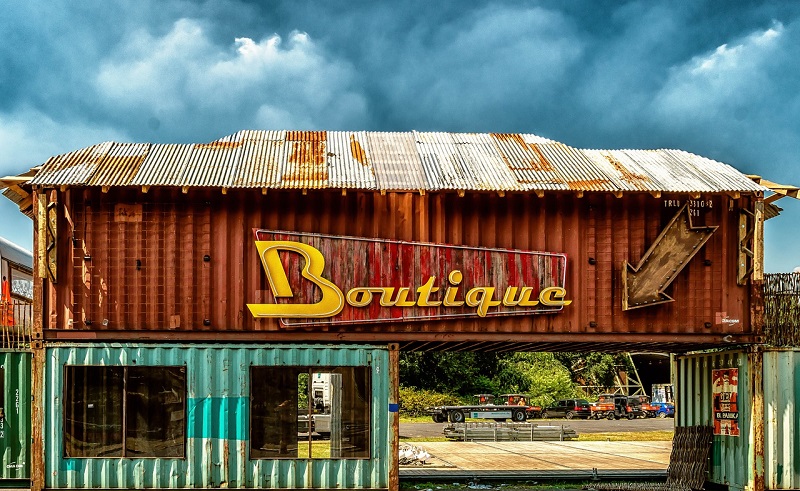Crinkly tin

|
| The roof of this small building made of old shipping containers is clad with a sinusoidal profile steel sheet. |
[edit] Introduction
‘Crinkly tin’ refers to sheets of profiled steel that are used for roofing and cladding buildings, mostly in industrial and other applications. The term is actually a misnomer as the sheeting is generally not made of tin. Today, the material mostly goes under the name of ‘profiled sheeting’, but may also be referred to as ‘wiggly’ or ‘wriggly’ tin, ‘corrugated iron’ or ‘galvanised sheets’.
Invented in 1829 as corrugated iron sheeting, the material was used in the late nineteenth century for building pre-fabricated buildings that were transported throughout the British Empire. It also became popular for agricultural sheds. Architects eventually found the material to be functional, durable, relatively economic, fast to install and with a potentially attractive ribbed texture and thus it came to be applied to numerous more permanent building types
Today, ‘crinkly tin’ is mainly made from galvanised or plastic-coated steel and is applied to elevations and roofs on a range of buildings that include warehouses, agricultural sheds, retail and industrial units, colleges and hospitals.
Specifiers can choose from a plethora of sheet types that are differentiated by their profile e.g trapezoidal or sinusoidal, pitch, thickness and colour. Sheets are also available that emulate roof tiles and pantiles at a fraction of the cost.
Generally used as a single skin, sheets for roofs are typically 0.7mm gauge and for walls 0.5mm gauge. Due to its thermal properties, condensation may occur either behind or below the sheeting. To avoid this, construction may incorporate insulation and vapour barriers.
[edit] Potential problems
It is common for steel sheeting to be coated with a very thin plastic layer to give protection against corrosion. However, this coating may be compromised on site when the material is cut to size, as the freshly cut edge will have no coating. The result is corrosion at the bare steel edge, and this will be exacerbated by rain and pollutants. Once corrosion starts, it can spread from the edges to other areas. Cut-edge corrosion is typically found at the eaves and sheet overlaps.
Corrosion may also occur when the metal expands in hot weather as the plastic coating may detach and allow water to penetrate. The ensuing corrosion may cause leaks and even perforation of the metal.
[edit] Related articles on Designing Buildings
Featured articles and news
One of the most impressive Victorian architects. Book review.
RTPI leader to become new CIOB Chief Executive Officer
Dr Victoria Hills MRTPI, FICE to take over after Caroline Gumble’s departure.
Social and affordable housing, a long term plan for delivery
The “Delivering a Decade of Renewal for Social and Affordable Housing” strategy sets out future path.
A change to adoptive architecture
Effects of global weather warming on architectural detailing, material choice and human interaction.
The proposed publicly owned and backed subsidiary of Homes England, to facilitate new homes.
How big is the problem and what can we do to mitigate the effects?
Overheating guidance and tools for building designers
A number of cool guides to help with the heat.
The UK's Modern Industrial Strategy: A 10 year plan
Previous consultation criticism, current key elements and general support with some persisting reservations.
Building Safety Regulator reforms
New roles, new staff and a new fast track service pave the way for a single construction regulator.
Architectural Technologist CPDs and Communications
CIAT CPD… and how you can do it!
Cooling centres and cool spaces
Managing extreme heat in cities by directing the public to places for heat stress relief and water sources.
Winter gardens: A brief history and warm variations
Extending the season with glass in different forms and terms.
Restoring Great Yarmouth's Winter Gardens
Transforming one of the least sustainable constructions imaginable.
Construction Skills Mission Board launch sector drive
Newly formed government and industry collaboration set strategy for recruiting an additional 100,000 construction workers a year.
New Architects Code comes into effect in September 2025
ARB Architects Code of Conduct and Practice available with ongoing consultation regarding guidance.
Welsh Skills Body (Medr) launches ambitious plan
The new skills body brings together funding and regulation of tertiary education and research for the devolved nation.
Paul Gandy FCIOB announced as next CIOB President
Former Tilbury Douglas CEO takes helm.






















